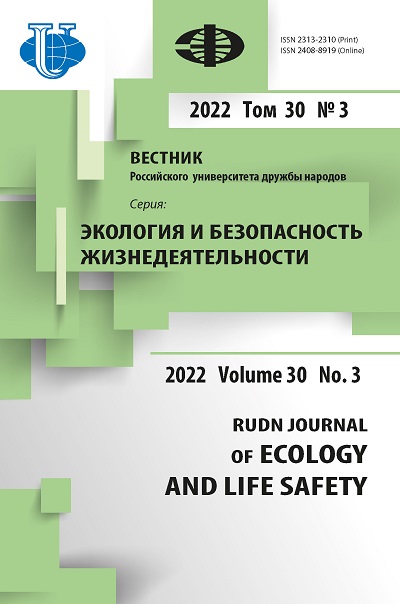Risk-based approach in food safety monitoring: algorithms for chemical pollutants ranking
- Authors: Makarov D.A.1, Balagula T.V.2, Lavrukhina O.I.3, Shirkin L.A.3
-
Affiliations:
- The Russian State Center for Animal Feed and Drug Standardization and Quality
- Federal Service for Veterinary and Phytosanitary Surveillance
- Vladimir State University named after A.G. and N.G. Stoletov
- Issue: Vol 30, No 3 (2022)
- Pages: 393-406
- Section: Environmental Monitoring
- URL: https://journals.rudn.ru/ecology/article/view/31898
- DOI: https://doi.org/10.22363/2313-2310-2022-30-3-393-406
Cite item
Full Text
Abstract
A risk-based approach in food safety monitoring suggests that the number analysis of contaminants and (or) products depends on the risk caused by product contamination, first of all for consumer health and economic (prevention of unsafe products realization). Risk-oriented sampling, planning and assignment of studies can be opposed with representative, aimed at obtaining reliable information about the contamination of the main types of products and conducted taking into account the requirements of mathematical statistics. The core of the various risk-based approaches as a rule is the ranking of contaminants/groups of contaminants and combinations of «contaminant-product» according to the risk degree. Ranking algorithms may be subdivided into qualitative (verbal characteristics) and quantitative (scores estimation). Algorithms for food chemical contaminants ranking proposed by authority agencies of the most successful in food safety countries are reviewed in this paper. The proposed approaches have a certain (sometimes limited) scope of application and provide scientifically based data for enhance compound control, unite toxicological characteristics, consumption, identification, and other information about xenobiotics. A serious limitation of the ranking effectiveness may be missing data of veterinary drugs (antibiotics) residues below maximum permissible level. There are additional but important criteria for health risk, the ability of drugs to cause pathogenic microorganisms’ resistance for the example.
Keywords
About the authors
Dmitry A. Makarov
The Russian State Center for Animal Feed and Drug Standardization and Quality
Email: phorez@yandex.ru
ORCID iD: 0000-0003-3834-0695
старший научный сотрудник, отделение фармакологических лекарственных средств, безопасности пищевой продукции и кормов
5 Zvenigorodskoye Shosse, Moscow, 123022, Russian FederationTatiana V. Balagula
Federal Service for Veterinary and Phytosanitary Surveillance
Email: loi1122@bk.ru
ORCID iD: 0000-0003-0583-4277
кандидат ветеринарных наук, начальник Управления государственного ветеринарного надзора
1/11 Orlikov per., Moscow, 107996, Russian FederationOlga I. Lavrukhina
Vladimir State University named after A.G. and N.G. Stoletov
Author for correspondence.
Email: hamsster@mail.ru
ORCID iD: 0000-0001-6248-5726
кандидат химических наук, доцент кафедры химии
87 Gor’kogo St, Vladimir, 600026, Russian FederationLeonid A. Shirkin
Vladimir State University named after A.G. and N.G. Stoletov
Email: hamsster@mail.ru
ORCID iD: 0000-0003-1622-9574
кандидат химических наук, доцент, доцент кафедры экологии
87 Gor’kogo St, Vladimir, 600026, Russian FederationReferences
- Chemical Contaminants and Residues in Food. Schrenk D., Cartus А. (eds.) Chemical Contaminants and Residues in Food (Second Edition). Woodhead Publishing; 2017.
- Pérez-Rodríguez F. Risk Assessment Methods for Biological and Chemical Hazards in Food (1st ed.). CRC Press; 2020. https://doi.org/10.1201/9780429083525
- Donchenko L.V., Nadykta V.D. Food safety. Part 1: textbook for academic baccalaureate. Moscow: Yurayt; 2019. (In Russ.)
- Garcia M, Verbruggen P, Fearne A. Risk-Based Approaches to Food Safety Regulation: What Role for Co-Regulation? Journal of Risk Research. 2013;16(9):1101–1121. https://doi.org/10.1080/13669877.2012.743157
- Institute of Medicine and National Research Council. Enhancing Food Safety: The Role of the Food and Drug Administration. Washington, DC: The National Academies Press, 2010. 588 p. https://doi.org/10.17226/12892
- Scientific Opinion on the public health hazards to be covered by inspection of meat (poultry). EFSA Journal. 2012;10(6):2741. https://doi.org/10.2903/j.efsa.2012.2741
- Maudoux J, Saegerman C, Rettigner C, Houins G, Huffel X, Berkvens D. Food safety surveillance through a risk-based control programme: Approach employed by the Belgian Federal Agency for the Safety of the Food Chain. The Veterinary quarterly. 2007;28:140–154. https://doi.org/10.1080/01652176.2006.9695220
- Saegerman C, Boelaert F, Vlanderen IV, Lomba M, Berkvens D, Ermens A, Biront P, Broeckaert F, Bernard A, Cock AD, Demont S, Poorter GD, Torfs B, Robijns J, Monfort V, Vermeersch JP, Lengelé L. Monitoring des animaux vivants: exemple d’un échantillonnage pour la détection des PCBs et dioxines chez les bovins de boucherie en Belgique. Epidémiol. et santé anim. 2000;38:39–49.
- Mathisen GH, Alexander J, Fæste CK, Husøy T, Knutsen KH, Ørnsrud R, Steffensen IL. A ranking method of chemical substances in foods for prioritisation of monitoring, based on health risk and knowledge gaps. Food Research International. 2020;137:109499. https://doi.org/10.1016/j.foodres.2020.109499
- Makarov DA, Prasolova OV. Special algorithm for planning of the risk based monitoring in food of animal origin. Issues of Legal Regulation in Veterinary Medicine. 2020;(3):175–178. (In Russ.)
















